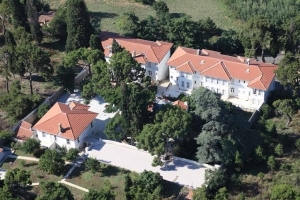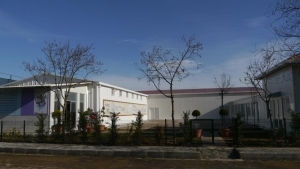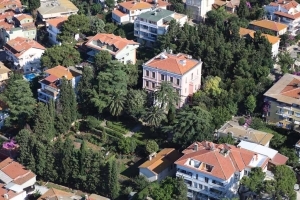Büyükada - Luna Park Meydanı
- Details
- Created on 05 April 2013
- Last Updated on 11 April 2013
The Monastery of St. Nicholas
 The monastery of St. Nicholas (Hagios Nikolaos) is on the eastern shore of the island, accessible by both the shore road and another road leading from the meydan below the summit of Yüce Tepe. The monastery is on or near the site of the Byzantine settlement of Karyes, which was abandoned in the seventeenth century after being devastated in a fire. The earliest mention of the monastery is by the English traveller Thomas Smith in 1680. The original katholikon of the monastery may have been built on and from the ruins of the parish church of Karyes. In 1783 the monastery temporarily housed a "School for Greek Classes," which subsequently was relocated near the Patriarchate in Istanbul as the Megale Scole, or Great School, which is still in existence.
The monastery of St. Nicholas (Hagios Nikolaos) is on the eastern shore of the island, accessible by both the shore road and another road leading from the meydan below the summit of Yüce Tepe. The monastery is on or near the site of the Byzantine settlement of Karyes, which was abandoned in the seventeenth century after being devastated in a fire. The earliest mention of the monastery is by the English traveller Thomas Smith in 1680. The original katholikon of the monastery may have been built on and from the ruins of the parish church of Karyes. In 1783 the monastery temporarily housed a "School for Greek Classes," which subsequently was relocated near the Patriarchate in Istanbul as the Megale Scole, or Great School, which is still in existence.
When the Greek War of Independence began in 1821 the monastery was taken over by the Turkish Army. Later it was restored and served to accommodate Greek families from Istanbul on visits to Prinkipo. A fire in 1852 destroyed the interior of the katholikon, including the iconostasis and most of the icons. The church was rebuilt in 1860 according to the original design, a domed four-columned cross-in-square, the plan of virtually all Constantinople churches of the medieval Byzantine era. The supposition is that the original katholikon preserved the plan of the parish church of Karyes, which is believed to have dated from the Byzantine period. The attractive narthex, covered with a tiled roof, dates to 1873. Over the entrance there is a marble relief of a double-headed eagle, emblem of the Palaeologus dynasty, who ruled Byzantium during its last two centuries. On the exterior at the northwest corner there is an ancient Greek relief representing a chariot race.
Museum of the Princes’ Islands - St. Nicholas Hangar Museum Site
 The St. Nicholas Hangar Museum Site, located in the fisrt settlement on Büyükada, is situated on a 1100m2 site.
The St. Nicholas Hangar Museum Site, located in the fisrt settlement on Büyükada, is situated on a 1100m2 site.
The 700 m2 enclosed area, permanent exhibition galleries of 400m2, a temporary exhibition hall of 225m2, as well as a museum shop, workshops, café, storage areas, archives and offices.
An additional open area of 400m2 is used to host various cultural activities, meetings and as an open exhibition area. The St. Nicholas Museum Site was opened on 10th September 2010, after 5 months of restoration work on the helicopter hangar Permanent exhibitions of the museum are housed here. During the first months of 2011, the permanent exhibition site began to be enlarged, and a new temporary exhibition area, storage area, Office and social areas were added.
Sapuncakis Köşkü
 A neoclassical building also known as Beyaz Sarayı, "White Palace"; built for Yorgi Sapuncakis Efendi by the Greek architect Fotiadis.
A neoclassical building also known as Beyaz Sarayı, "White Palace"; built for Yorgi Sapuncakis Efendi by the Greek architect Fotiadis.
Vatikan Büyükelçiliği Köşkü
 Vatican Embassy Villa: the future Pope John XXXIII lived here when he was Papal Nuncio in Istanbul.
Vatican Embassy Villa: the future Pope John XXXIII lived here when he was Papal Nuncio in Istanbul.
Rosolato Köşkü
Mehmet Şakir Paşa, Ottoman diplomat; Princess Fahrünissa, painter, wife of the Emir Zeid; Aliye Berger-Boronai, painter; Cevat Şakir Kabaağaçli, writer, better known as the Fisherman of Halicarnassus; Füreya Kılıç Ali, ceramicist; Şirin Devrim, actress.


 Princes' Islands
Princes' Islands 